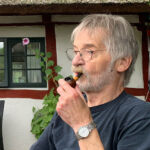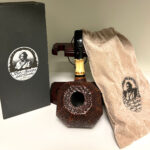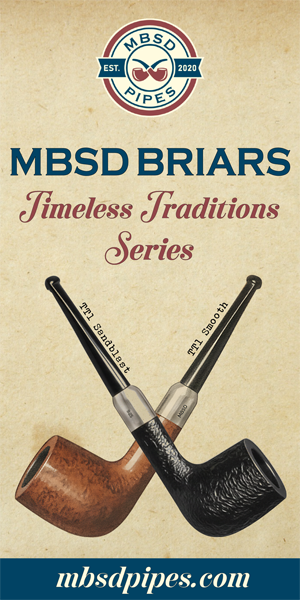By Bob Tate
 Russ Ouellette (Blendtobac) is the Retail Sales Manager and Master blender for Habana Premium Cigar Shoppe (HPCS), also known as Pipesandcigars.com, in Albany, New York. Russ has been involved in the tobacco industry for over 30 years. He is regarded as one of the best blenders in the country and has created over 100 different pipe tobacco blends over the years, many of which are still being sold today. Russ is probably best known for the Hearth & Home Series of pipe tobacco blends that he has created for HPCS (pipesandcigars.com). I had the opportunity to talk with Russ at length about pipe tobacco and a few other things. Here is Part 1 of our interview with Russ Ouellette:
Russ Ouellette (Blendtobac) is the Retail Sales Manager and Master blender for Habana Premium Cigar Shoppe (HPCS), also known as Pipesandcigars.com, in Albany, New York. Russ has been involved in the tobacco industry for over 30 years. He is regarded as one of the best blenders in the country and has created over 100 different pipe tobacco blends over the years, many of which are still being sold today. Russ is probably best known for the Hearth & Home Series of pipe tobacco blends that he has created for HPCS (pipesandcigars.com). I had the opportunity to talk with Russ at length about pipe tobacco and a few other things. Here is Part 1 of our interview with Russ Ouellette:
PipesMagazine (PM): Russ, you have been involved in the tobacco business on and off for over 30 years, what else have you done besides blending pipe tobacco?
Russ Ouellette: I’ve traveled a winding path. Besides that, I spent a number of years in the automotive business, I’ve done sign painting, I supervised 15 bowling pro shops and trained ball drillers, and was in the computer sales area for awhile. Also piano and organ sales, so I’ve done quite a few different things.
PM: That’s a pretty extensive background.
Russ: Yeah, it’s rather eclectic.
PM: How long have you been actually blending pipe tobacco blends?
Russ: Well, I’ve done it for about 30 years. I started doing it when I first worked, during college and after graduation, at a chain store. Then when I left the business, I still did it because I had old customers and friends who used to like some of the things that I made and they would ask me to make them for them. So I continued to do it right on through, but the heavy lifting has been in the last 5 years.
PM: What got you started in blending? Was it just your love for the tobacco leaf?
Russ: Yeah, and when I started in the 70’s, if you had a shop it was probably going to do about 70% pipe and pipe tobacco business and the rest of it was going to be cigars and cigarettes. So, you really needed to know something about blending. People were always coming in and taking something from one of the jars and going “That’s too sweet, it’s not spicy enough” or whatever, so you had to learn to tweak the blends. And from there it went to; well, if I can tweak them, I can make my own. So I started developing a few and putting them out on the counter, they were pretty successful and it became a regular part of my routine and they continued to sell those blends after I left that company.
Then when I came to work for Scott [Bendett], the business had flip flopped completely where 80% of the business was cigars and it almost seems like the majority of retailers had forgotten the pipe smoker. So, when I came on board with Scott, it was his thought that I should help build that end of the business back up and one of the ways that I could do that is by giving him unique blends that couldn’t be bought anywhere else. We tried it and it was successful right from the beginning. So we continue to do it and we continue to try and grow that end of the business.
PM: As far as each of the individual batches that you make; do you make all of the batches yourself or do have others help you in keeping the blends fully stocked?
Russ: I would say probably 98% of it is myself. On occasion, if I’m at the Chicago Show or something like that and they need something, they’ve run out; I do have somebody here who I’ve been working with who can put together a batch and knows what I’m looking for, so I’m not concerned about the consistency. But everybody in this company has plenty of responsibilities, so for right now it’s just me. As things go forward, if we continue to expand and grow, I’m going to have to bring somebody in on a more regular basis to help me with it.
PM: I can imagine that it would get quite overwhelming trying to keep up with the demand.
keep up with the demand.
Russ: Yeah. Last year the Hearth & Home tobaccos, we sold over 3,000 pounds.
PM: Wow, that’s impressive!
Russ: And over 500 pounds of that alone was Anniversary Kake.
PM: Are you also the blender for the HPCS (Habana Premium Cigar Shop) Adirondack Series and the Scotty’s Bulk Blends?
Russ: I’ll put those together, but I’m not the one who came up with the blends. Because those are mixtures of, for the most part, aromatics or blends that were given to us by previous employees or customers. They existed before I ever came on board. But Trout Stream and Butternut Burley are extremely popular; those tobaccos have done well for quite some time.
PM: What is your favorite type of tobacco to blend with or do you even have a favorite?
Russ: It really depends on my frame of mind at the time. Sometimes it has to a lot to do with the time of year. This time of year in Albany, New York it’s cold. So during the winter, my tendencies and my smoking habits tend to go more towards English and Balkan blends. During the warmer weather, I’ll start getting a little bit more into the Virginia and Virginia/Perique blends and Burley blends will pop in and out of my head at different times. I don’t have a particular favorite, but there are some tobaccos that are chameleons and I like them for that reason.
Perique to me is probably the biggest chameleon. You use it in one blend and it makes the blend sweet. You use it in another blend and it makes it spicy. Combine it with other things and it takes on a completely different flavor profile. It’s really an interesting tobacco to work with because sometimes you think you have an idea of what the end product is going to be like and you put it together and try it and it’s completely different than what you thought. So I enjoy working with Perique. I do love Latakia there’s just something about the aroma of Latakia that it makes me feel at home.

PM: Latakia is pretty nice. While we’re on the subject of Perique, I’ve noticed that almost half of the blends in the Hearth & Home Series contain Perique. In our article, The Mystique of Perique, we had an interview with Mark Ryan, the owner of L.A. Poche Perique Tobacco, and he was talking about the two different kinds of Perique; Acadian and St. James. What type do you prefer to use and why?
Russ: It depends on the blend. Some blends we use St. James, some blends we use the Acadian Perique. It’s going to depend on the tobacco. If I’m using a base tobacco that’s got a rather intense flavor to it, then I’m going to have to use the St. James Perique to stand up to it. If I’m using the lighter base tobaccos like a Carolina, white Burley, or a yellow Virginia then I’ll probably use Acadian Perique because I don’t want the Perique to overwhelm the blend. Sometimes I’ll make a batch with one and then I’ll make another batch with the other and after trying them, determine that what I originally thought didn’t work as well. With Perique, it really is a matter of experimentation because you really can not tell for sure until you’re smoking it what the end result is going to taste like.

PM: With the exception of Syrian Latakia, have you ever had a problem acquiring a certain tobacco component?
Russ: Oh, absolutely. Most of the Orientals. When I first started doing this, there was a company in New York City called Tobacco Center. I could call them up and they probably had 15 to 20 different varietals available in one pound bags. So, I could call them up and tell them I wanted a pound of Yenidje, a pound of Xanthia, a pound of Bashi Bagli and the next day or the day after, I would have my tobacco to work with. Today, I can only get mixtures of Oriental tobaccos or a very few straight Oriental mixers. I have been trying to find a source, but I haven’t had a lot of success doing that. From time to time I get my hands on some small batches, and when I do then I can do something special with it. For International Pipe Smoking Day this year, I put together a blend. Unfortunately, I had to keep the batch so small because of the availability of the other tobaccos that it’s not going to be available to the general public. It’s going to be for people who are on our mailing list basically. It’s got some Yenidje and some Basma in it, which, now I’m kind of wiping away a tear because the last of the Yenidje is gone.
PM: Wow, I didn’t know it was all gone, but it does sound like it will be a tasty blend.
Russ: It’s an interesting one; it’s a very complex blend, medium to medium-full English. But there are five different Orientals in it so it’s a unique blend. I just wish that I could reproduce it. But unless somebody comes up with an easy source for me to buy those other tobaccos, it’s not going to happen. There’s a company that I can buy some Oriental tobacco from, but first off I have to buy it uncut and I don’t have the equipment for cutting tobacco. On top of that, on initial contact, they wanted an order of a metric ton.
PM: Oh, Wow!
Russ: Yeah. We’re not that big of an operation. I did 3,000 pounds last year of Hearth & Home and I’ve been at the Altadis plant when they were making one batch of Mixture 79 and that was around 2,000 pounds. So you know, we don’t do that kind of volume where I can say “Yeah, I’ll take a metric ton of Bashi Bagli or Samsun, or whatever” I mean I can’t do it.
PM: No, that’s a lot of tobacco.
Russ: Yeah.
PM: With the different variables with weather and tobacco from year to year, how do you maintain the consistency of your blends?
Russ: Well, I don’t think I’m really telling the secret. I do something similar to the way Macanudo does their cigars. What they do is; they take tobacco from different years and age them together.
PM: To get a more consistent blend from year to year?
Russ: Yeah. What I’ll do is; when I get an order of tobacco in and I check it against what I currently have on the shelf, if there is a difference between them then what I will do is start mixing them together and gradually increasing the amount of the new and decreasing the amount of the old. So you get a little bit more of a cross section. Thankfully because most of the tobaccos are not fermented; even with climatic conditions being different, the soil conditions being different, the difference generally doesn’t seem to be as radical as it is when you’re growing cigar leaf. There fermentation can make a huge difference. You know, they let this batch get up to a little higher temperature and the flavor profile changes. Because most of the pipe tobaccos are cut, dried, processed, and cased to some degree or another, there seems to be a little less inconsistency with pipe tobacco. But you still have to. I’ve gotten back to back batches of tobacco and noticed a significant difference in aroma, flavor, and appearance. So, you do definitely kind of have to do that.
PM: What are some of the major changes that you have seen in the pipe industry over the years that you have been involved?
See Russ’ answer to this question, if he is working on any new blends, and many more in Part 2 of our interview with Russ Ouellette!

















